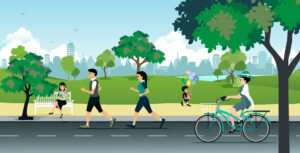Typically, people tend to favor neighborhoods with more trees in them. However, this is more than just an aesthetic reason for this. Studies conducted across the country have shown that there are immense psychological benefits that trees can have on an entire neighborhood. Here’s a few reasons why trees create a more stable, inviting, and happy community…
Better Soil
Another terrific attribute of tree roots is how immensely beneficial they are for our soil. How healthy soil is can be dependent on a whole host of different factors. There needs to be a careful balance of different nutrients and organisms in the soil to preserve life and make it healthy for things to grow in. Wind and water runoff can destroy that balance. The tree roots absorb runoff water and take in the contaminants that destroy soil’s ecological balance, while the tree trunks, branches, and leaves mitigate the amount of wind that affects the soil.
Increased property values
Simply having trees in a neighborhood can raise the property value of the entire area. Even homes with trees in between the sidewalk and the street, all things considered, sold for $7,130 more than those without. This is essentially the same as adding another 129 square feet of finished space to your home, just from trees. In this same study, they also showed that those same trees would increase the value of neighboring homes by $1700, even if they didn’t have any trees of their own.
Saves energy
Trees around homes act as a natural insulator. They are able to keep the home cool during the hot, summer seasons, while they also provide a great wind blocker during the winter, which can have a major impact on how much wind chill affects your home’s temperature. All of these things are able to save money. Simple having three trees around your home in strategic spots could reduce your air conditioning costs by up to 30%, and a similar amount during the winter for your gas bill. This results in less electricity and burning fossil fuels.
Diversifies wildlife
Trees in a neighborhood bring in more species to the local wildlife population. Various mammals use trees for shelter, food, or resources. However, with less trees, these smaller mammals may become extinct in an area, which can affect the ecological balance. The migratory patterns of birds are also affected by trees in a neighborhood. This is important to note, because having more wildlife in a neighborhood can have mood benefits, as well.
Better psychological health
In a recent Chicago study, 98 apartments buildings were studied based on the psychological welfare of their inhabitants. Those with trees around the buildings exhibited less violent or paranoid behavior. This means that urban areas without public trees may be particularly susceptible to such negative behaviors. Families in areas with more trees reported having more peace of mind and feeling more stable. These effects can ripple throughout a community, affecting everyone.

